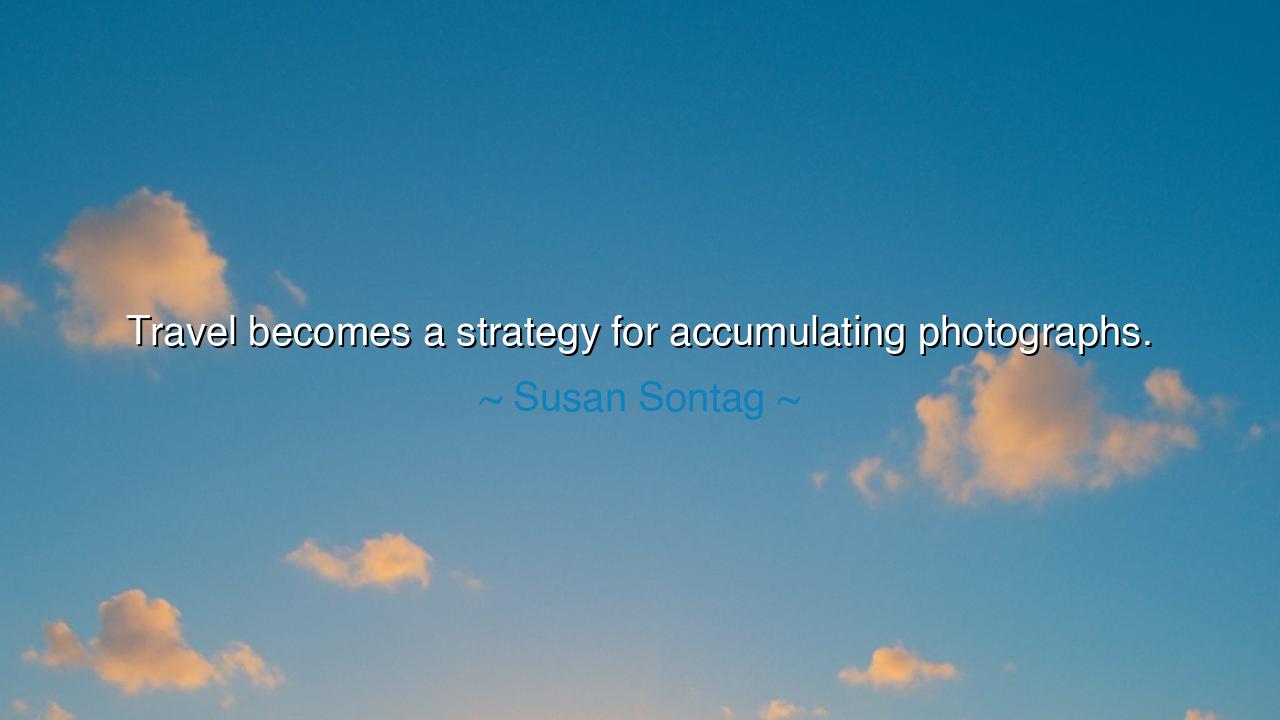
Travel becomes a strategy for accumulating photographs.






Hear, O children of the wandering spirit, the words of Susan Sontag, who once proclaimed: “Travel becomes a strategy for accumulating photographs.” At first, the saying seems but an observation on the habits of modern travelers, who with camera in hand pursue every sight as though to capture it. Yet behind her words lies a deep reflection on how humanity seeks to grasp the fleeting, how we confuse possession with experience, and how the hunger for memory sometimes overtakes the joy of the moment itself.
The ancients knew well the yearning to preserve what passes. The poets sang, the sculptors carved, the scribes etched upon stone so that no deed or vision would fade into dust. But Sontag reveals a new age, where photographs replace poems, and journeys become less about seeing and more about recording that one has seen. The mountains, the seas, the cathedrals of old—these are no longer simply encountered with awe, but are framed, cropped, and stored as trophies of passage. Thus, travel becomes less about transformation of the soul and more about proof of movement through space.
Consider the tale of the Grand Tour of Europe, once undertaken by nobles and scholars in centuries past. They journeyed not merely to witness sights but to deepen their minds, to study ancient ruins, to absorb the art of Florence and the philosophy of Paris. Their journals and sketches were not trophies but meditations. Today, Sontag suggests, many journeys have shifted into a kind of hunt for images: the Leaning Tower of Pisa is not admired for its marvel, but posed with; the streets of Venice are not wandered in contemplation, but consumed through the lens.
Yet let us not scorn the camera altogether. For a photograph is also a form of memory, a fragment of time rescued from oblivion. When used with reverence, it can become a portal to reflection, reminding the heart of places it once knew. The danger lies not in the taking, but in the forgetting—that one must first live the moment before seeking to capture it. When the click of the shutter replaces the beat of the heart, then travel becomes hollow, a gallery of images without depth.
Sontag’s insight strikes at the core of our restless age: we fear that without proof, the moment is lost. But the ancients would say that the truest proof lies not in an image, but in the soul transformed by the journey. Did the desert teach you patience? Did the mountain teach you endurance? Did the sea teach you humility? If so, then you carry the journey within, and no photograph is needed. If not, then all the photographs in the world are but empty shells.
The lesson, therefore, is clear: let not your travel become merely a strategy of accumulation. Travel as a seeker, not as a collector. Let the sights you behold enter your soul before they enter your camera. Pause before the temple, breathe the air of the forest, hear the silence of the desert, and let these things carve themselves into your being. Take photographs, yes, but let them be footprints after the walk, not replacements for the walk itself.
Practically, this means setting aside the lens from time to time. When you arrive at a place of beauty, give it first to your eyes, your ears, your heart. Speak with those who live there, taste their food, share their stories. Only then, when the experience has become part of you, capture it if you wish. For a photograph should not be the goal of travel, but the shadow of something deeper.
So let these words be remembered: Travel not to accumulate images, but to accumulate wisdom. For the soul that seeks transformation will carry its own inner gallery, invisible to the world yet eternal within. And when the photographs fade, as all things fade, it is this inner gallery that will remain, shining with the true light of experience.






AAdministratorAdministrator
Welcome, honored guests. Please leave a comment, we will respond soon